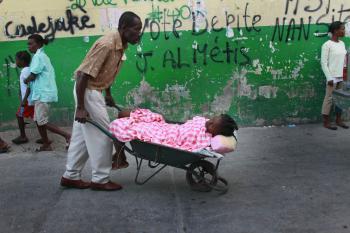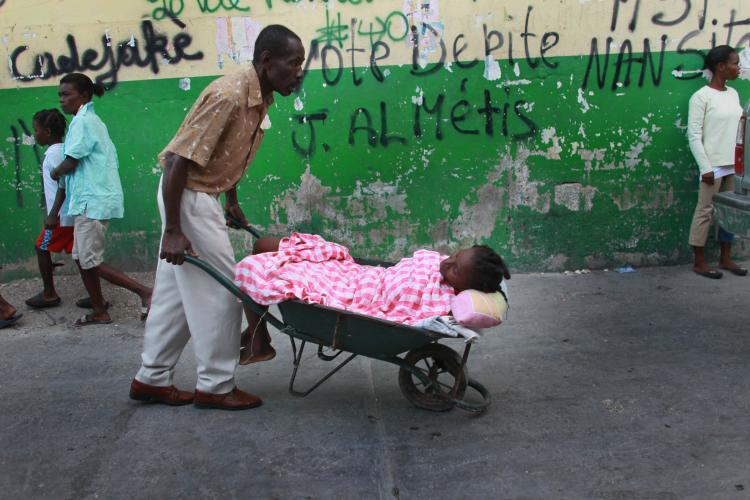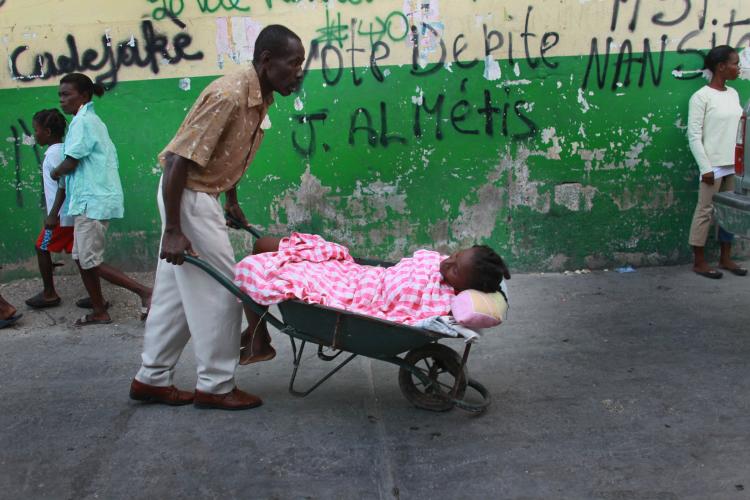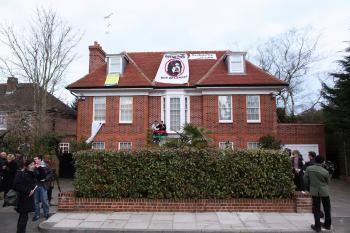Unnecessary amputations and the shock to Haiti’s national health system after last January’s earthquake could have been prevented by better preparation and coordination by the thousands of aid organizations that flooded Haiti in 2010, says a one-year assessment report by U.K. medical charity Merlin.
A year after the devastating 7.0-magnitude earthquake struck Haiti on Jan. 12, 2010, relief organizations are looking back and evaluating the results of their efforts.
Merlin, the U.K.’s leading charity specializing in international health, on Monday published its report, “Is Haiti’s Health System any Better?” The report reviewed the medical assistance provided by the international community to Haiti.
Within days of the disaster, non-governmental organizations (NGOs) started pour into Haiti to provide assistance. The epicenter of the earthquake was only 10 miles from the capital, with a population of 2 million inhabitants. Seventy percent of Port-au-Prince’s buildings crumbled, killing over 200,000 and the falling debris creating a large number of crush victims and causing other injuries.
The concept of mobile medical teams, optimal for responses in rural areas like Indonesia and Kashmir, didn’t work in Haiti. More specialized orthopedic and plastic surgeons should have been included in the relief teams to deal with the crush injuries, concluded Merlin. Many amputations could have been prevented if such specialists had been there, says the report.
The loss of a limb in a developing country is devastating. “In a resource poor environment of a developing country, an amputated extremity is tantamount to a life sentence of hardship and poverty, aside from the social stigma,” the report states, quoting an e-mail from a volunteer with the Pediatric Orthopedic Society of North America.
Having more of the right kind of equipment could save more lives in a similar situation in the future, concluded Medicines Sans Frontiers (MSF) in its Haiti analysis published Jan. 10.
The international medical and humanitarian aid organization wrote that next time, the detection and treatment of “crush syndrome” should receive more emphasis. Internal injuries can release toxins into the blood, which in normal situations healthy kidneys would filter out. Untreated, crush syndrome can be fatal. MSF had one dialysis unit operational within a week—it could only take care of about 0.1 percent of the potential number of patients in Haiti.
Having the right people and equipment for the situation should be put to the best use by better coordination. Within the first four weeks of the quake, 400–600 medical relief NGOs had arrived in Haiti. MSF International President Dr. Unni Karunakara wrote in a piece for the Guardian that as of last month, 12,000 NGOs were operating in Haiti.
According to Merlin, when international NGOs arrived in Haiti, they took over, most assuming local healthcare infrastructure was nonexistent. However, though damaged, local medical resources did exist and were already engaged in relief efforts.
“One Haitian surgeon reported going to the General Hospital to offer her services only to be told the international team had brought enough foreign personnel with them,” the report states.
As a consequence of not cooperating with local health organizations, or carelessly taking them over, communication with patients and local staff was hampered, for example by the language barrier. Some people didn’t know if they were getting an injection or amputation, the report states.
Some NGOs, already in-country before the quake, such as MSF, did use local staff. MSF says it had 11 times more local staff than international staff. However, they too suffered in the quake. A survey by the Haitian Ministry of Health, cited in Merlin’s report, found that two-thirds of healthcare workers lost their homes and 245 lost a spouse or child.
A year after the disaster, Haiti’s own health care system is still under stress. In some cases, international NGOs settled inside existing health centers, taking them over, and recruiting local nurses and health workers themselves. This, together with the fact that they provide free healthcare, puts extra stress on Haiti’s national health system, which is dependent on fees. Additional pressure results from the needs of amputees and people suffering from trauma and psychological disorders.
Merlin recommends that in future scenarios, international NGOs should assess national health worker capacities and local needs, include local NGOs and civil society in emergency decision-making, and work toward the long-term development of local health care resources.
A year after the devastating 7.0-magnitude earthquake struck Haiti on Jan. 12, 2010, relief organizations are looking back and evaluating the results of their efforts.
Merlin, the U.K.’s leading charity specializing in international health, on Monday published its report, “Is Haiti’s Health System any Better?” The report reviewed the medical assistance provided by the international community to Haiti.
Within days of the disaster, non-governmental organizations (NGOs) started pour into Haiti to provide assistance. The epicenter of the earthquake was only 10 miles from the capital, with a population of 2 million inhabitants. Seventy percent of Port-au-Prince’s buildings crumbled, killing over 200,000 and the falling debris creating a large number of crush victims and causing other injuries.
The concept of mobile medical teams, optimal for responses in rural areas like Indonesia and Kashmir, didn’t work in Haiti. More specialized orthopedic and plastic surgeons should have been included in the relief teams to deal with the crush injuries, concluded Merlin. Many amputations could have been prevented if such specialists had been there, says the report.
The loss of a limb in a developing country is devastating. “In a resource poor environment of a developing country, an amputated extremity is tantamount to a life sentence of hardship and poverty, aside from the social stigma,” the report states, quoting an e-mail from a volunteer with the Pediatric Orthopedic Society of North America.
Having more of the right kind of equipment could save more lives in a similar situation in the future, concluded Medicines Sans Frontiers (MSF) in its Haiti analysis published Jan. 10.
The international medical and humanitarian aid organization wrote that next time, the detection and treatment of “crush syndrome” should receive more emphasis. Internal injuries can release toxins into the blood, which in normal situations healthy kidneys would filter out. Untreated, crush syndrome can be fatal. MSF had one dialysis unit operational within a week—it could only take care of about 0.1 percent of the potential number of patients in Haiti.
Having the right people and equipment for the situation should be put to the best use by better coordination. Within the first four weeks of the quake, 400–600 medical relief NGOs had arrived in Haiti. MSF International President Dr. Unni Karunakara wrote in a piece for the Guardian that as of last month, 12,000 NGOs were operating in Haiti.
According to Merlin, when international NGOs arrived in Haiti, they took over, most assuming local healthcare infrastructure was nonexistent. However, though damaged, local medical resources did exist and were already engaged in relief efforts.
“One Haitian surgeon reported going to the General Hospital to offer her services only to be told the international team had brought enough foreign personnel with them,” the report states.
As a consequence of not cooperating with local health organizations, or carelessly taking them over, communication with patients and local staff was hampered, for example by the language barrier. Some people didn’t know if they were getting an injection or amputation, the report states.
Some NGOs, already in-country before the quake, such as MSF, did use local staff. MSF says it had 11 times more local staff than international staff. However, they too suffered in the quake. A survey by the Haitian Ministry of Health, cited in Merlin’s report, found that two-thirds of healthcare workers lost their homes and 245 lost a spouse or child.
A year after the disaster, Haiti’s own health care system is still under stress. In some cases, international NGOs settled inside existing health centers, taking them over, and recruiting local nurses and health workers themselves. This, together with the fact that they provide free healthcare, puts extra stress on Haiti’s national health system, which is dependent on fees. Additional pressure results from the needs of amputees and people suffering from trauma and psychological disorders.
Merlin recommends that in future scenarios, international NGOs should assess national health worker capacities and local needs, include local NGOs and civil society in emergency decision-making, and work toward the long-term development of local health care resources.




